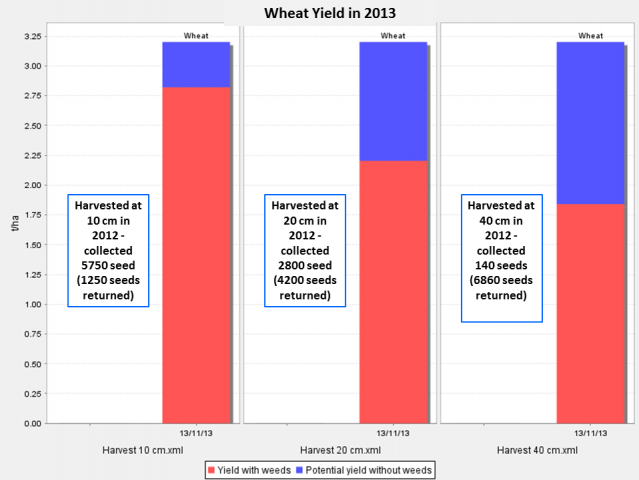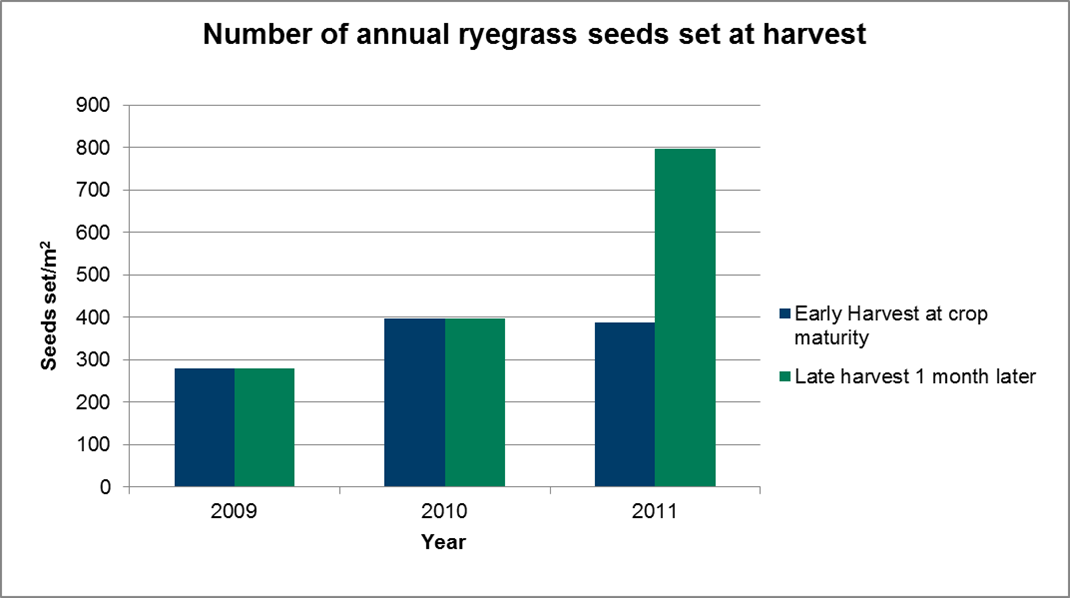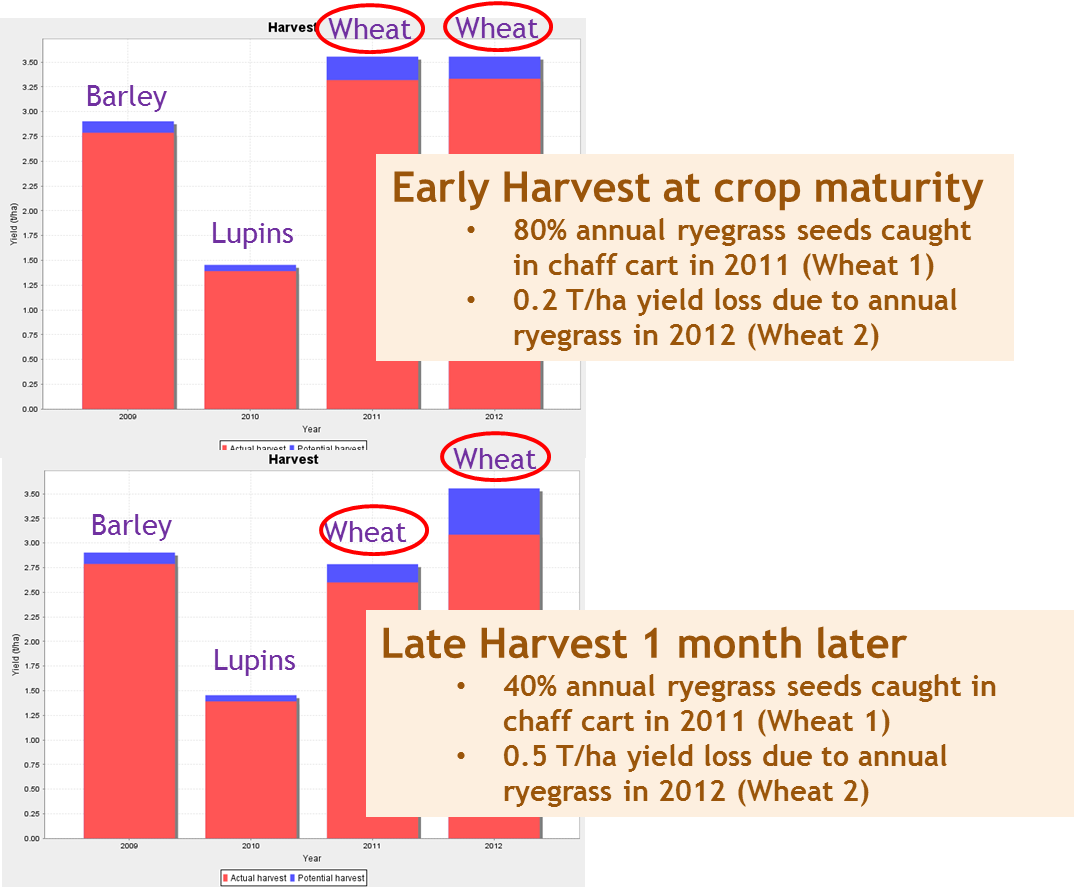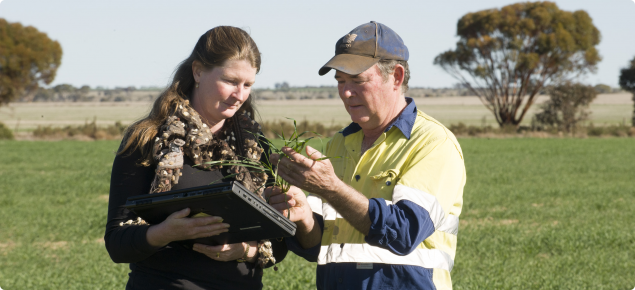Grower from Western Australia's central wheatbelt
One grower in WA's central wheatbelt, Kevin Walsh, crops approximately half of his farm (predominantly wheat, barley and canola) and also runs 1600 sheep. His major weeds are annual ryegrass and wild radish and he manages them by spray-topping pastures and crop-topping lupins. He sacrifices his weedy paddocks to feed his sheep and follows up with a knockdown on those crop paddocks.
He tried the Weed Seed Wizard model to assess the weed seedbanks in a number of paddocks. The Wizard gave quantitative backing to some of the ideas that the Walshes are considering for future weed control and potential changes to their weed management strategy.
Harvest seed management is one area of interest to Kevin, so he used the Wizard to look at how adding a chaff cart to collect weed seeds at harvest impacted on future weed levels. Without having to purchase and use a chaff cart, Kevin was able to gauge the effect of harvest weed seed collection on the weed density in the paddock over time and determine the value of such an investment.
Don't stop doing harvest weed management just because its a dry year
Work done by Australian Herbicide Resistance Initiative (AHRI) has shown that annual ryegrass seed numbers can still be relatively high in poor seasons (see Table 1). In 2012, 29 annual ryegrass plants per square metre produced 7000 seeds. These seeds can carry over to the following year to reduce yields.
| Year | Wheat yield (t/ha) | Annual ryegrass (plants/m2) | Annual ryegrass (seeds/m2) |
|---|---|---|---|
| 2011 | 4.0 | 19 | 12 000 |
| 2012 | 0.6 | 29 | 7000 |
(Note the comparative ryegrass seed yields for the two seasons. There was not much of a yield penalty for ryegrass in the drought year, 2012, when compared with wheat).
Cut your crop lower in a dry year to catch more ryegrass seeds
In a good year, with a big crop, there will be less light penetration and the annual ryegrass tillers will be upright and easier to catch. In a low-yielding year with a light crop and an open canopy, the ryegrass tillers will be also shorter. The work done by AHRI showed that a 40cm harvest height in 2011 (high yielding crop) collected about 60% ryegrass seed at crop maturity compared to about 2% in 2012 (low yielding crop).
The more seeds dropped in one year, the less yield in the following year
To illustrate the difference in cutting height in a dry year, we simulated the wheat yields in 2013 after 7000 annual ryegrass seeds/m2 were set in 2012 using the Weed Seed Wizard. If the crop was cut at 10cm, only 1250 ryegrass seeds/m2 are returned to the seedbank with a resulting 400 kilograms per hectare (kg/ha) of wheat yield loss the next season. This compares to a yield loss of 1.4 tonnes per hectare (t/ha) when the crop is cut at 40cm and most of the ryegrass seeds are dropped (Figure 1).

Also in dry years where wheat yield is low, it is possible to burn narrow windrows in wheat. For wheat crops of 2-2.5t/ha or less it is possible to burn just the windrows. Cutting low is imperative to keep the fire in the windrow and to optimise the burn.
An early versus a late harvest
In 2007, Nigel Metz from the South East Premium Wheatgrowers Association (SEPWA) developed an online tool, the SEPWA Harvest Calculator. This economic model works on the theory that a crop can be harvested sooner by harvesting for longer periods each day under high-moisture conditions, limiting exposure to yield and quality loss. It is:
- Pertinent to harvest programs that are delayed by high grain moisture levels
- Yield decreases by approximately 0.5% per day after crop maturity for cereal crops along south coast of WA
- Without weeds, the gross margins for both early and late harvests are usually the same; the cost of a reduced yield of a late harvest equals the cost of delivery penalties for high moisture levels at early harvest which equals the cost of blending or drying high moisture grain at an early harvest
- But, the risk of weather damage increases the later the harvest.
What about the extra yield loss in the following year due to dropped weed seed?
At grain maturity, a large percentage of annual ryegrass seeds can be captured by harvest weed seed management, either by a chaff cart, by burning narrow windrows or by using a Harrington Seed Destructor™. Delaying harvest, however, can allow weed seeds to drop on the ground prior to their capture. In weedy paddocks therefore, the risk of reduced yields the following year due to an increased seedbank also increases the later the season.
Using the Weed Seed Wizard, we examine a barley-lupin-wheat-wheat rotation on the south coast of WA with annual ryegrass (2009-12). There are two scenarios:
- Early harvest in 2011 (wheat year) using a chaff cart – 80% annual ryegrass collected (blue bars in Figure 2).
- Late harvest in 2011 (wet harvest) – 40% of annual ryegrass seeds collected (green bars in Figure 2).

A late harvest in 2011 resulted in greater yield loss due to weeds in 2012 that the earlier harvest (Figure 2).

What is the decision?
- Harvest early although the grain moisture levels are higher and accept the increase in delivery costs.
- Catch more annual ryegrass in the chaff cart and produce 0.3t/ha of wheat more in 2012.



